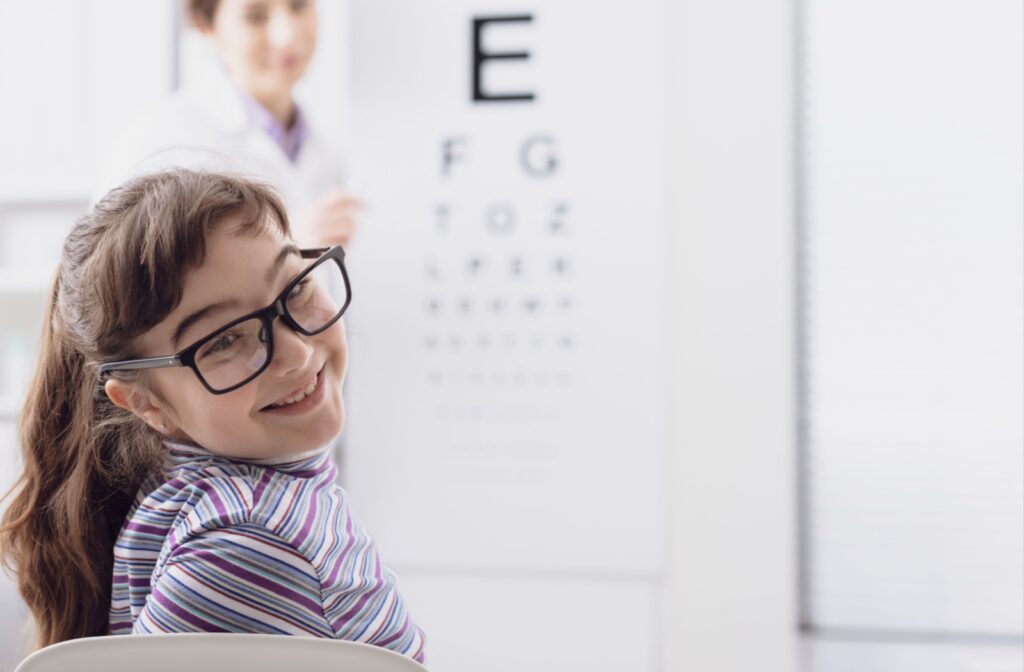Your child’s eyesight is an important aspect of their overall health and development. As a parent, we know setting your child up for success and caring for their health is a top priority—and children’s eye exams are a key part of this.
During a typical eye exam for kids, the optometrist will assess your child’s visual acuity, eye alignment, and overall eye health. The exam may involve using letter charts for reading, looking through various lenses, and conducting tests to check for potential vision problems.
Depending on your child’s age and developmental stage, the optometrist might also use special instruments to examine the inside of the eye. We aim to make this process friendly and engaging, focusing on creating an enjoyable experience for young patients.
What Happens in a Kids’ Eye Exam?
A typical kids’ eye exam will include the following components:
- Assessment of Visual Acuity: This involves reading letters on an eye chart to evaluate how well your child can see at different distances. The optometrist might use a standard letter chart or one designed specifically for children with pictures or shapes instead of letters.
- Eye Alignment and Movement Test: The optometrist will check how well your child’s eyes are aligned and move in unison to ensure they are working together properly.
- Eye Health Checkup: This part of the exam is crucial, as it allows the optometrist to check for any abnormalities or signs of diseases in your child’s eyes. They may use special instruments to look at the retina and other structures inside the eye.
- Refractive Error Assessment: Refractive errors are common vision problems that can affect children. These include nearsightedness, farsightedness, and astigmatism. During the exam, the optometrist will use lenses to determine if your child has a refractive error that requires correction.
- Color Vision Test: This test helps identify any color blindness or deficiencies in color perception.
- Eye Coordination Test: The optometrist may ask your child to follow a moving object with their eyes or perform other tests to assess their eye coordination skills.
- Additional Tests: Depending on the results of the initial tests, the optometrist may order additional tests to further evaluate your child’s vision and eye health.
Preparing for a Kids’ Eye Exam
Here are some tips to help prepare your child for their eye exam:
- Explain What Will Happen: It is essential to talk to your child beforehand and explain what will happen during the exam. This can help alleviate any fears or anxiety they might have.
- Discuss Any Concerns or Symptoms: If your child has been experiencing any specific vision problems or symptoms, make sure to let the optometrist know before the exam so they can address them.
- Gather Relevant Information: Bring any previous eyeglasses or contact lens prescriptions, as well as information about any family history of eye problems.
- Make Sure They Are Well-Rested: Getting enough sleep and rest before the exam can help your child stay alert and focused during the appointment.
- Bring Comfort Items: If your child has a favorite toy or blanket that helps them feel comfortable, bring it along to the appointment to help them relax.

Scheduling an Eye Exam During Back to School
It is recommended that children have an eye exam before starting or at the beginning of a new school year. Here’s why:
- Identify and Correct Vision Problems: An eye exam can reveal any vision issues your child may have, like nearsightedness, farsightedness, or astigmatism. Correcting these can enhance their academic performance and overall quality of life.
- Prevent Learning and Developmental Delays: Undetected vision problems can greatly affect a child’s learning and development. Early detection through an eye exam can prevent delays caused by vision issues.
- Monitor Eye Health: Regular eye exams allow optometrists to check your child’s eye health and catch potential problems early, such as lazy eye or crossed eyes, which need prompt treatment for the best chance of correction.
- Update Prescription: As children grow, their vision may change, necessitating a new prescription for glasses or contacts. An eye exam before school starts ensures they have the correct prescription for optimal vision.
- Prepare for Screen Time: With technology increasingly used in schools, it’s important to monitor your child’s vision and ensure they aren’t experiencing strain or discomfort while using screens. An eye exam can help address this and provide solutions if needed.
Tips for Scheduling an Eye Exam
Here are some tips to help you schedule an eye exam before your child goes back to school:
- Plan Ahead: Don’t wait until the last minute to schedule an eye exam. Start planning a few weeks before school starts to ensure you can find a convenient appointment time.
- Check Your Insurance Coverage: If you have vision insurance, make sure to check your coverage and see if it covers annual eye exams for children. This can help save you money on the cost of the exam.
- Consider Timing: Choose a time when your child is well-rested and not hungry. This will ensure they are comfortable during the exam and can provide accurate responses to the optometrist’s questions.
- Communicate Any Concerns: Before the exam, communicate any concerns you have about your child’s vision or potential eye problems. This will help the optometrist focus on those areas during the exam.
Comprehensive Eye Care for Children at Envision Eye Care
It is important to prioritize your child’s eye health by taking them for regular eye exams. Following these steps and preparing your child beforehand can help make the experience more comfortable and productive for both of you.
At Envision Eye Care, we understand the importance of children’s eye health and offer comprehensive eye exams for children of all ages. Schedule an appointment today to be on top of your child’s eye health and to prepare them for the upcoming school year.



